Part 2: Workload
What Will You Do¶
In this part of the self-paced exercise, you will deploy a Windows workload to the Windows node on the MKS Cluster.
Step 1: Create Namespace¶
In this step, we will create a namespace using the web console. The namespace will be used to deploy workloads in future steps.
- Navigate to the project in your Org where the cluster is located.
- Select Infrastructure -> Namespaces
- Click "New Namespace"
- Enter "windows" for the name
- Select "Wizard" for the Type
- Click "Save"
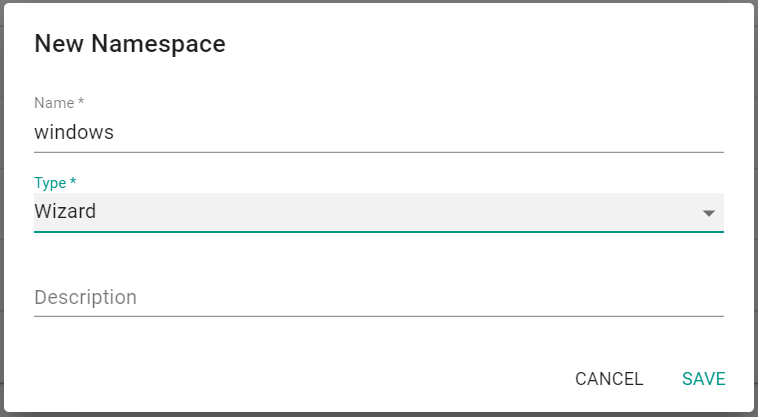
- Click "Save & Go To Placement"
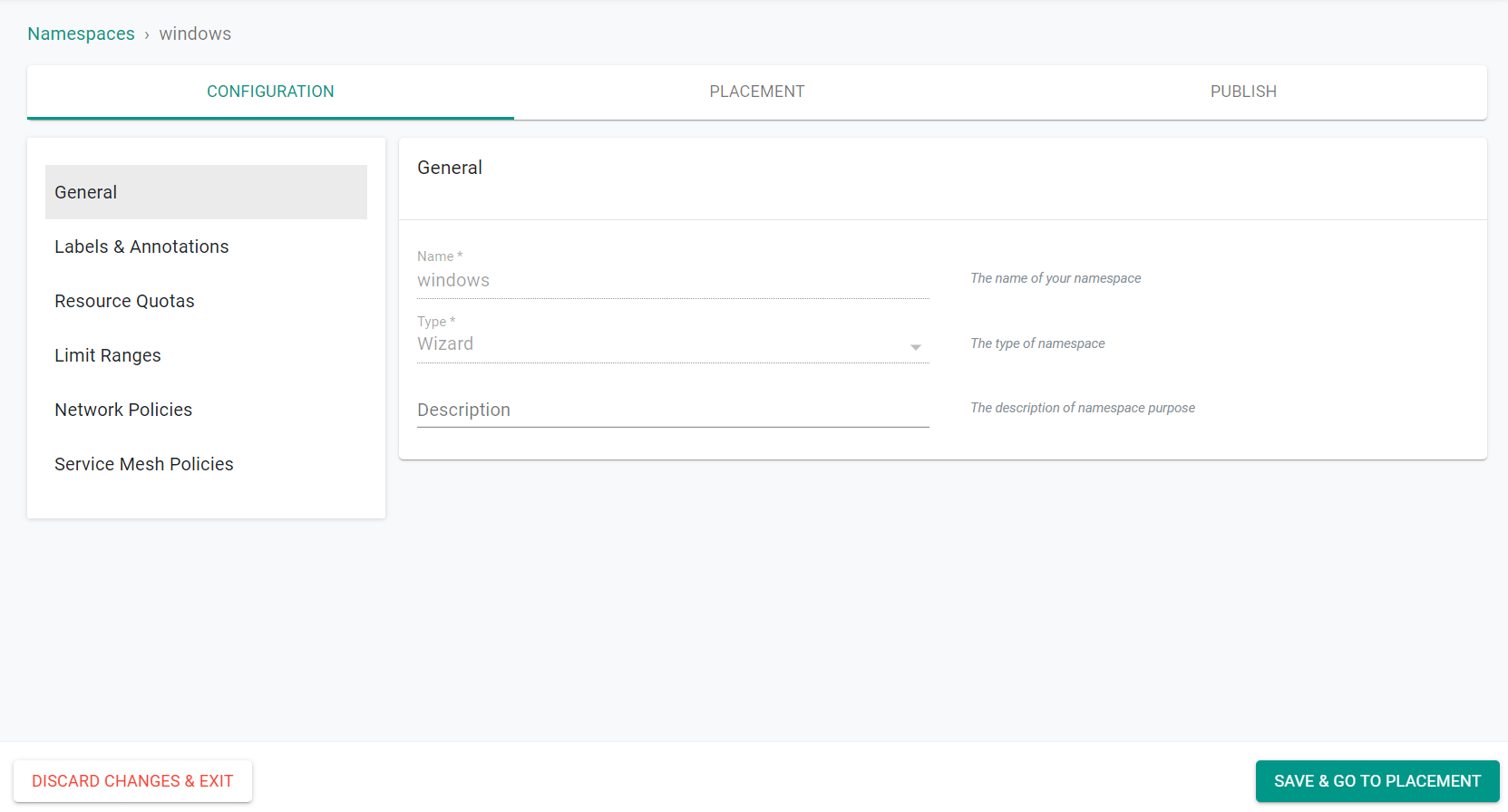
- Select the cluster to create the namespace on
- Click "Save & Go To Publish"
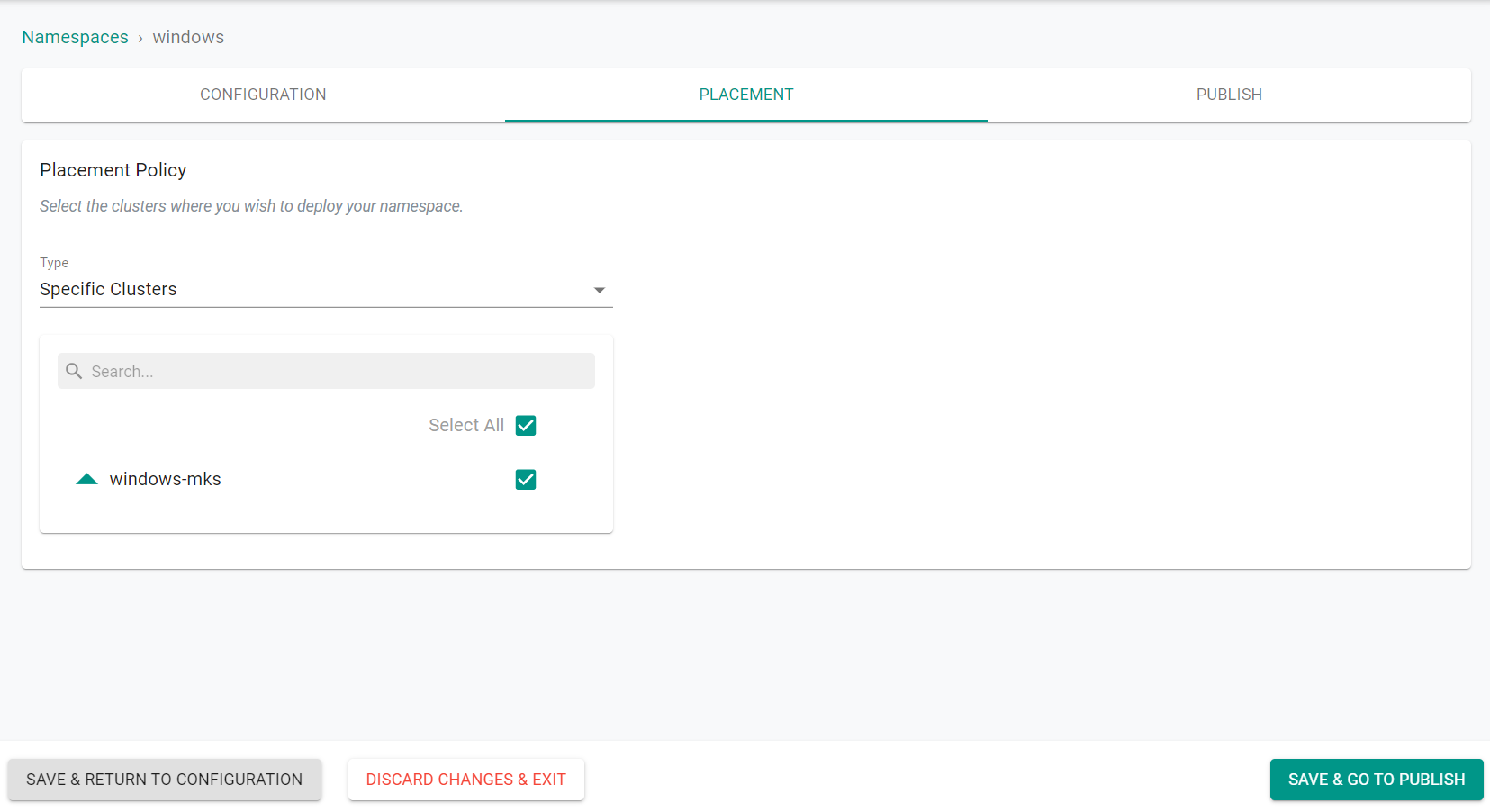
- Click "Publish"
The namespace is now published on the cluster.

- Click "Exit"
Step 2: Deploy Windows Workload¶
In this step, we will deploy a Windows workload into the previously created namespace.
- Navigate to the project in your Org where the cluster is located.
- Select Applications -> Workloads
- Click "New Workload" -> "Create New Workload"
- Enter "windows-workload" for the name
- Select "k8s YAML" for the Package Type
- Select "Upload files manually"
- Select the "Windows" namespace
- Click "Continue"
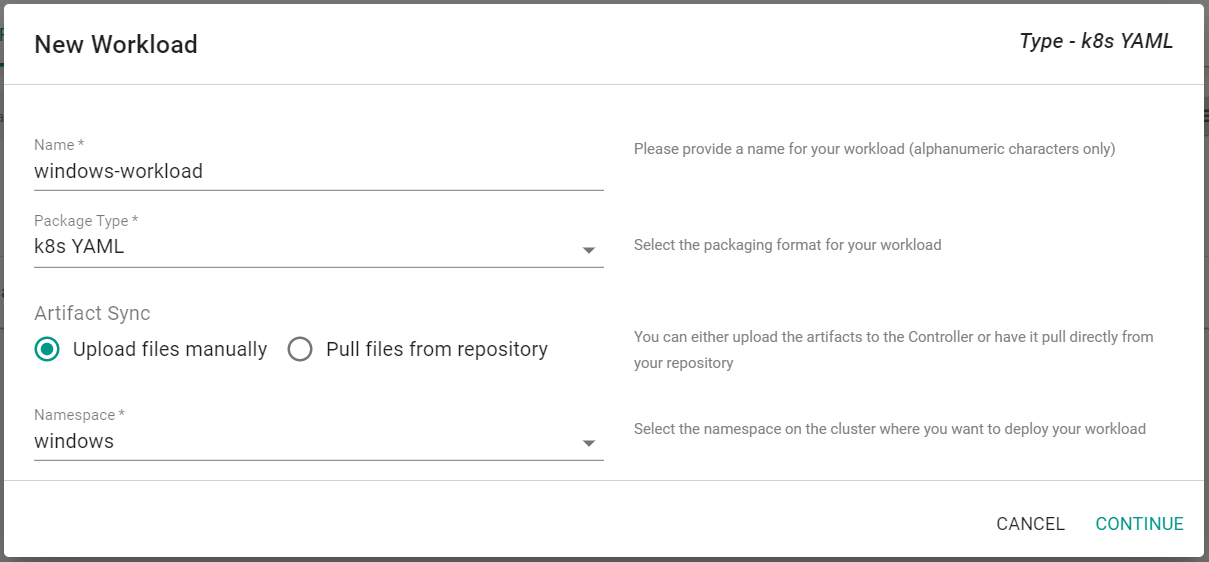
- Save the below specification file to your computer as "windows-workload.yaml".
Important
The 'nodeSelector' section, lines 40 & 41, specifies which OS to use. This is an important configuration to specify to avoid scheduling issues. Without a nodeSelector configuration, this deployment could be scheduled on a Linux node, causing it to fail. Kubernetes scheduling doesn't recognize Operating System, rather it is based on scores. For more information, please visit https://kubernetes.io/docs/concepts/scheduling-eviction/kube-scheduler/ .
apiVersion: v1
kind: Service
metadata:
name: win-webserver
labels:
app: win-webserver
spec:
ports:
# the port that this service should serve on
- port: 80
targetPort: 80
selector:
app: win-webserver
type: NodePort
---
apiVersion: apps/v1
kind: Deployment
metadata:
labels:
app: win-webserver
name: win-webserver
spec:
replicas: 2
selector:
matchLabels:
app: win-webserver
template:
metadata:
labels:
app: win-webserver
name: win-webserver
spec:
containers:
- name: windowswebserver
image: mcr.microsoft.com/windows/servercore:ltsc2019
command:
- powershell.exe
- -command
- "<#code used from https://gist.github.com/19WAS85/5424431#> ; $$listener = New-Object System.Net.HttpListener ; $$listener.Prefixes.Add('http://*:80/') ; $$listener.Start() ; $$callerCounts = @{} ; Write-Host('Listening at http://*:80/') ; while ($$listener.IsListening) { ;$$context = $$listener.GetContext() ;$$requestUrl = $$context.Request.Url ;$$clientIP = $$context.Request.RemoteEndPoint.Address ;$$response = $$context.Response ;Write-Host '' ;Write-Host('> {0}' -f $$requestUrl) ; ;$$count = 1 ;$$k=$$callerCounts.Get_Item($$clientIP) ;if ($$k -ne $$null) { $$count += $$k } ;$$callerCounts.Set_Item($$clientIP, $$count) ;$$ip=(Get-NetAdapter | Get-NetIpAddress); $$header='<html><body><H1>Windows Container Web Server</H1>' ;$$callerCountsString='' ;$$callerCounts.Keys | % { $$callerCountsString+='<p>IP {0} callerCount {1} ' -f $$ip[1].IPAddress,$$callerCounts.Item($$_) } ;$$footer='</body></html>' ;$$content='{0}{1}{2}' -f $$header,$$callerCountsString,$$footer ;Write-Output $$content ;$$buffer = [System.Text.Encoding]::UTF8.GetBytes($$content) ;$$response.ContentLength64 = $$buffer.Length ;$$response.OutputStream.Write($$buffer, 0, $$buffer.Length) ;$$response.Close() ;$$responseStatus = $$response.StatusCode ;Write-Host('< {0}' -f $$responseStatus) } ; "
nodeSelector:
kubernetes.io/os: windows
- Click "Choose File" to upload the previously created YAML file
- Click "Save and Go To Placement"
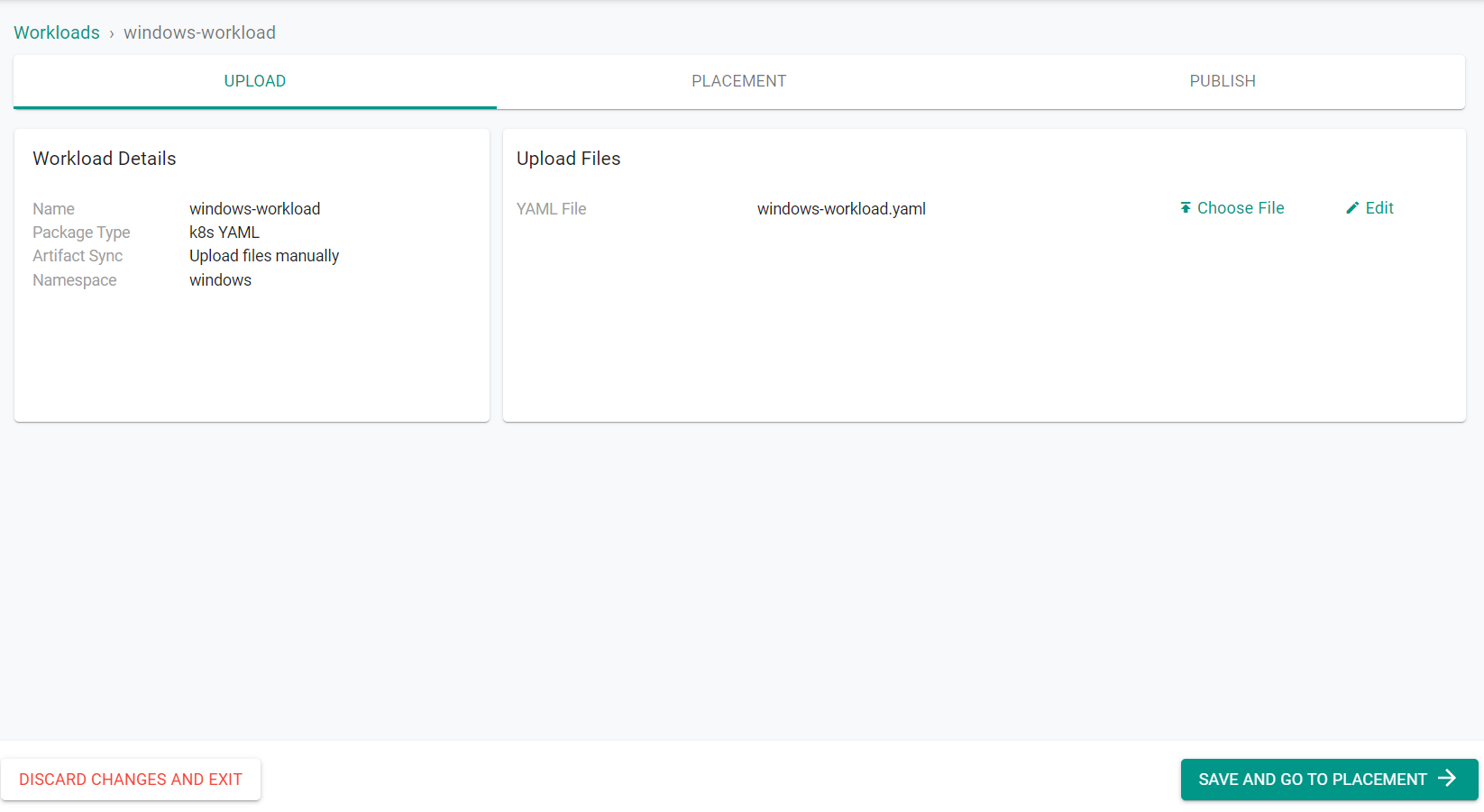
- Select the cluster to deploy the workload on
- Click "Save & Go To Publish"

- Click "Publish"
The workload is now published on the cluster.
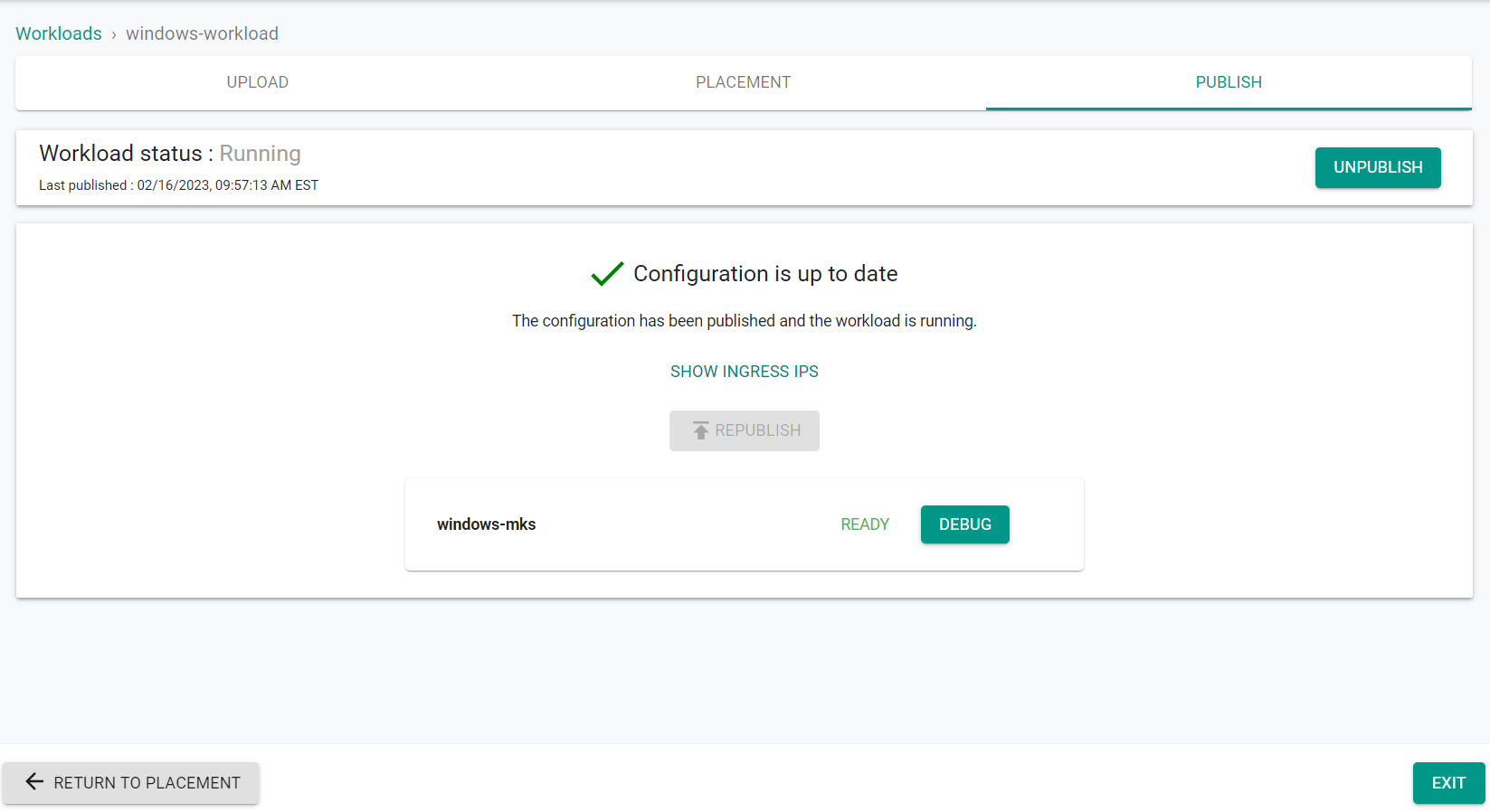
- Click "Exit"
Step 3: Validate Workload¶
In this step, we will verify the Windows workload is running and accessible.
- Navigate to the project in your Org where the cluster is located.
- Select Infrastructure -> Clusters
- Click on the kubectl link of the cluster and type the following command
kubectl get pods -n windows
You should see output similar to the following showing the windows workload running
NAME READY STATUS RESTARTS AGE
win-webserver-df5876b96-4d7vm 1/1 Running 0 118s
win-webserver-df5876b96-6jt26 1/1 Running 0 118s
- Enter the following command
kubectl get services -n windows
You should see output similar to the following showing the Cluster IP address of the service the workload is using.
NAME TYPE CLUSTER-IP EXTERNAL-IP PORT(S) AGE
win-webserver NodePort 10.108.133.57 <none> 80:31125/TCP 2m38s
- Enter the following command on the linux node. Be sure to update the cluster-ip address with the ip address previously obtained.
curl <cluster-ip>
You should see output similar to the following showing the web response from the windows workload.
<html><body><H1>Windows Container Web Server</H1><p>IP 10.244.138.9 callerCount 1 </body></html>
Recap¶
Congratulations! At this point, you have successfully provisioned a Windows workload running on an MKS cluster.